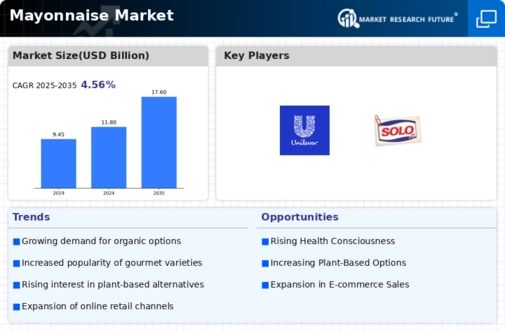Top Industry Leaders in the Mayonnaise Market
 The Mayonnaise market, a substantial segment within the global condiments and sauces industry, exhibits a competitive landscape shaped by factors such as changing consumer preferences, demand for healthier alternatives, and the influence of global culinary trends. As of 2023, key players in this market strategically position themselves to navigate these dynamics, employing various strategies to maintain or augment their market share.
The Mayonnaise market, a substantial segment within the global condiments and sauces industry, exhibits a competitive landscape shaped by factors such as changing consumer preferences, demand for healthier alternatives, and the influence of global culinary trends. As of 2023, key players in this market strategically position themselves to navigate these dynamics, employing various strategies to maintain or augment their market share.
Key Players:
Unilever (U.K.)
Paradise Food Ltd (U.K.)
Marina Foods Inc. (U.S.)
AR Brands (South Africa)
Solo Foods (South Africa)
Delicacy Foods (Cyprus)
ADM Antwerp (Belgium)
Strategies Adopted:
Key players in the Mayonnaise market employ diverse strategies to remain competitive. Continuous innovation in product formulations, adaptation to evolving dietary trends, and responsiveness to consumer demands for healthier and cleaner label options are central strategies. These companies invest in research and development to create mayonnaise alternatives that cater to specific dietary preferences, such as low-fat, organic, or plant-based options. Strategic partnerships with restaurants, food chains, and influencers contribute to expanding the market reach and product visibility of mayonnaise brands. Marketing efforts often emphasize brand reliability, taste, and versatility of their mayonnaise products.
Market Share Analysis:
Market share analysis in the Mayonnaise market is influenced by several factors, including brand reputation, product quality, pricing strategies, and distribution efficiency. Companies with strong brand equity and a history of producing high-quality mayonnaise products tend to secure a larger market share. Pricing strategies that balance affordability with the perceived value of mayonnaise offerings play a crucial role, given the competition with other condiments and sauces and the price sensitivity of consumers. Effective distribution networks, encompassing both traditional retail channels and e-commerce platforms, are vital for maintaining a competitive edge.
New and Emerging Companies:
While key players dominate the Mayonnaise market, new and emerging companies are entering the sector, often focusing on specific product categories or introducing innovative formulations. These entrants may emphasize unique ingredients, sustainable sourcing, or cater to niche markets with specialized mayonnaise variations, contributing to the overall diversification and innovation in the Mayonnaise market. Although their market share may be relatively modest compared to industry leaders, these companies play a role in driving trends and meeting the evolving demands of consumers seeking unique and premium mayonnaise options.
Industry Trends:
The Mayonnaise market has witnessed noteworthy industry news and investment trends in 2023. Key players are investing in sustainability initiatives, responding to the growing consumer awareness of environmental impact and responsible sourcing. Collaborations with suppliers of quality ingredients, efforts to reduce packaging waste, and initiatives to ensure traceability contribute to maintaining a consistent and responsibly sourced supply chain for mayonnaise production. Additionally, investments in technology adoption, such as advanced production methods and digital traceability, aim to enhance production efficiency and maintain the quality and freshness of mayonnaise products.
Competitive Scenario:
The overall competitive scenario in the Mayonnaise market is marked by intense rivalry among key players striving to capture a larger share of the growing market. The industry's competitiveness is evident in the emphasis on innovation, sustainability, and strategic collaborations to address evolving consumer preferences and regulatory requirements. The global reach of these companies enables them to adapt to regional flavor preferences, capitalize on emerging markets, and navigate complex regulatory landscapes, contributing to the overall dynamism of the industry.
Recent Development:
World Flavours: There was a greater inclination to experiment with tastes from other countries. Kewpie increased the popularity of its sriracha mayo, and Duke's introduced a line of foods influenced by Asian flavours like yuzu and gochujang.
spicier Offers: Sriracha and chipotle-infused mayonnaise variants from companies like Sir Kensington's and Primal Kitchen have been increasingly popular as the market for spicy mayonnaise grows.


